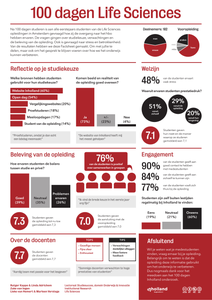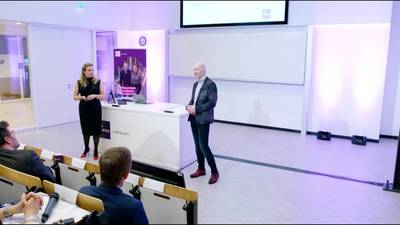Na 100 dagen studeren is aan alle eerstejaars studenten van de Life Sciences opleidingen in Amsterdam gevraagd hoe zij de overgang naar het hbo hebben ervaren. De vragen gingen over studiekeuze, verwachtingen en de beleving van de opleiding. Ook is gevraagd naar stress en betrokkenheid. Van de resultaten hebben we deze factsheet gemaakt.
DOCUMENT

De Regiegroep van de topsector Life Sciences & Health wil een impuls geven aan initiatieven die praktijkgericht onderzoek op het gebied van Health betreffen. De redenen hiervoor zijn de relatief bescheiden positie van Health vergeleken bij de Life Sciences in de eerdere agendering onder de topsector en de verwachting dat praktijkgericht onderzoek door hogescholen een substantiële bijdrage kan leveren aan de doelstellingen onder het topsectorenbeleid. Daarom is opdracht gegeven tot het opstellen van een agenda voor praktijkgericht onderzoek “Health”. Deze agenda moet leiden tot samenwerking met een solide economische component tussen hogescholen, eventuele andere kennisinstellingen en publieke en private partijen uit de beroepspraktijk. De Agenda Praktijkgericht Onderzoek Health is ingedeeld in vier overkoepelende thema’s (A - D) waarop het onderzoek van hogescholen zich zou moeten richten. Binnen elk thema zijn onderwerpen benoemd die op basis van deze verkenning prioriteit verdienen.
DOCUMENT

De opleiding Life Sciences & Chemistry in het domein AFL wil aansluiten bij ontwikkelingen in het werkveld en didactisch vernieuwen, gericht op de activering van studenten. Hierbij wordt van een beredeneerde inzet van video veel verwacht, vooral bij de curriculumonderdelen die studenten als lastig ervaren. De onderwijseenheid ‘Basischemie’ (blok 1, jaar 1) wordt gezien als een ‘struikelvak’. Een focusgroep met studenten maakte duidelijk dat niet alleen de stof, maar vooral ook de werkwijze in het hbo verschilt van die in de havo. Daarom is besloten tot een herontwerp van de didactiek. Doel van het onderzoek is samen met de betrokken pionier en docent die dit onderwijsonderdeel verzorgt, een uitwerking met inzet van video’s te genereren en te testen, waarbij de video’s aansluiten bij de hoorcolleges, opdat het ontwerp leidt tot actieve betrokkenheid van studenten bij het onderwijs en een beter begrip van de leerstof. Studenten vinden het logisch om voorafgaand aan een hoorcollege de video’s te bekijken en zijn positief over de gecombineerde aanpak van video’s en hoorcolleges. Het ontwerp heeft het ervaren probleem opgelost: de voorkennis is voorafgaand aan het hoorcollege geactiveerd, de oriëntatie op het hoorcollege vond plaats, en het tijd- en plaatsonafhankelijk leren is versterkt. De docent had in het hoorcollege meer tijd over voor extra verwerkingsopdrachten.
DOCUMENT

Praktijkgericht onderzoek speelt een belangrijke rol binnen de University of Applied Sciences van onze Hogeschool Inholland. Wij hebben dan ook een ijzersterk verhaal te vertellen en een schat aan relevante onderzoeksresultaten om te laten zien. En dat willen we graag delen met de wereld. Binnen ons praktijkgericht onderzoek werken we aan maatschappelijke vraagstukken. Soms groot en globaal, soms klein en regionaal. Maar altijd om de praktijk verder te helpen. Waarom? Omdat we vinden dat het onze maatschappelijke taak is. Het draagt bij aan de professionele ontwikkeling van onze studenten en aan innovatie en ontwikkeling van het werkveld . De onderzoeksgroep, Research & Innovation Centre, van het domein Agri, Food & Life Sciences wordt gevormd door lectoren, docent-onderzoekers en natuurlijk studenten. Samen met partners uit het werkveld dragen wij bij aan de Sustainable Development Goals en de Greendeal Farm to Fork (EU). Ons onderzoek en de kennisvalorisatie draagt bij aan innovatieve en duurzame ontwikkelingen, denk aan circulaire land- en tuinbouw, dieren in de stad, natuur, leefomgeving, voedsel en voeding, bodem, klimaatadaptatie en biodiversiteit.
DOCUMENT

Tijdens bezoek van SBE (Samenwerkende Bedrijven Eemsdelta) aan de Hanzehogeschool is deze poster gepresenteerd
DOCUMENT

De Haagse Hogeschool heeft 'Kwaliteit van het leven: technologie voor gezondheid' tot een van haar profileringsthema's benoemd. Daarmee wil zij inspelen op maatschappelijke behoeften en tevens bijdragen aan een reductie van de zorgkosten. Aansluiting wordt gezocht bij het topsectorenbeleid Life Sciences & Health en de Europese onderzoeks- en innovatieagenda voor 2020; the European Innovation Partnership on Active and Healthy Ageing.
DOCUMENT

Gebruikt bij post-bachelorcursus Using R for Data Analysis: "... verdiep je je in de programmeertaal R. Dit is een programmeertaal die reproduceerbaarheid van onderzoek en data-analyse verhoogt. R wordt tegenwoordig breed gebruikt binnen verschillende takken van de wetenschap en daarnaast door grote data gedreven bedrijven als Facebook en Google". Zie https://www.hu.nl/deeltijd-opleidingen/using-r-for-data-analysis
DOCUMENT
Hogescholen starten in 2022 met een eigen doctoraatstraject: het Professional Doctorate. Daarmee introduceert het hbo een nieuwe beroepsopleiding waarmee het de grenzen in de beroepspraktijk wil verleggen. Kandidaten worden opgeleid tot hooggekwalificeerde professionals die leren te interveniëren in complexe vraagstukken zoals de energietransitie of de gezondheidszorg. Belangrijke en noodzakelijke toevoeging Hogescholen zien een doctoraatstraject in het hbo als een belangrijke en noodzakelijke toevoeging binnen het hoger onderwijs stelsel. Het Professional Doctorate (PD) maakt een doorlopende leerlijn van bachelor via master tot doctorate in de beroepskolom mogelijk, en wordt nauw verbonden met het overige hbo-onderwijs. Doel is dat hbo bachelor- en masterstudenten in hun onderwijs de vruchten plukken van het onderzoek van PD-kandidaten naar de laatste ontwikkelingen in de beroepspraktijk. Daarmee is de introductie van het professional doctorate ook een investering in de bredere aansluiting van het hbo op de arbeidsmarkt.
DOCUMENT

Op 22 februari 2022 spraken dr. Anne Loonen en dr. Joost Schoeber hun lectorale rede uit, tijdens een bijeenkomst in gebouw Nexus van Fontys Hogescholen op de campus van de TU/e Eindhoven. Daarin spraken ook dr. Jan Bernards, lector Thin Films & Functional Materials bij het lectoraat Applied Natural Sciences), dr. Adriaan van den Brule (Jeroen Boschziekenhuis), dr. ir. Ivo Roessink (Wageningen University and Research) en prof. dr. Maarten Merkx (TU/e).
YOUTUBE

Research conducted by Universities of Applied Sciences (UASs) is frequently driven by professional practice where researchers are challenged with finding solutions to real-life problems. These real-life solutions are significantly enhanced by the participation of stakeholders. Through this inclusion and the resulting interactions, activities, and knowledge transfer, between the stakeholder and research(ers), impacts occur at a micro level. Micro impacts are the normal impacts that occur during the research process through interactions between researchers and stakeholders, that facilitate an unexpected and unplanned effect, be it positive or negative (Lykke et al. 2023, Mapping Research Activities and Societal Impact by Taxonomy of Indicators: Uniformity and Diversity across Academic Fields, Journal of Documentation, 79: 1049–70). Contribution analysis has been recognized as a viable method for evaluating micro impacts. One recognized contribution analysis framework is Kok and Schuit’s (2012, Contribution Mapping: A Method for Mapping the Contribution of Research to Enhance Its Impact, Health Research Policy and Systems, 10: 21) Contribution Mapping. It is also one of the frameworks acknowledged as conforming to several of the recommendations for evaluating UAS research impact. However, to do justice to the nature of Practice Oriented research, a new framework is needed. The purpose of this article is to test how Contribution Mapping works in real-life to answer the question: What can we learn from Contribution Mapping as an impact evaluation tool for a future UAS specific research impact evaluation framework? This article will examine the specificity of UAS research, the relevance of Contribution Mapping for evaluating UAS research, and the theoretical and practical implications of Contribution Mapping. Through inductive analysis conducted on information gleaned from interviews and focus groups, observations, challenges, and limitations are identified, and modifications suggested to take into consideration for a new framework.
DOCUMENT